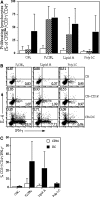Using distinct molecular signatures of human monocytes and dendritic cells to predict adjuvant activity and pyrogenicity of TLR agonists
- PMID: 18283493
- PMCID: PMC2757590
- DOI: 10.1007/s00430-008-0081-6
Using distinct molecular signatures of human monocytes and dendritic cells to predict adjuvant activity and pyrogenicity of TLR agonists
Abstract
We present a systematic study that defines molecular profiles of adjuvanticity and pyrogenicity induced by agonists of human Toll-like receptor molecules in vitro. Using P(3)CSK(4), Lipid A and Poly I:C as model adjuvants we show that all three molecules enhance the expansion of IFNgamma(+)/CD4(+) T cells from their naïve precursors following priming with allogeneic DC in vitro. In contrast, co-culture of naive CD4(+) T cells with allogeneic monocytes and TLR2/TLR4 agonists only resulted in enhanced T cell proliferation. Distinct APC molecular signatures in response to each TLR agonist underline the dual effect observed on T cell responses. Using protein and gene expression assays, we show that TNF-alpha and CXCL10 represent DC-restricted molecular signatures of TLR2/TLR4 and TLR3 activation, respectively, in sharp contrast to IL-6 produced by monocytes upon stimulation with P(3)CSK(4) and Lipid A. Furthermore, although all TLR agonists are able to up-regulate proIL-1beta specific gene in both cell types, only monocyte activation with Lipid A results in detectable IL-1beta release. These molecular profiles, provide a simple screen to select new immune enhancers of human Th1 responses suitable for clinical application.
Figures







References
-
- {'text': '', 'ref_index': 1, 'ids': [{'type': 'DOI', 'value': '10.1038/ni1112', 'is_inner': False, 'url': 'https://doi.org/10.1038/ni1112'}, {'type': 'PubMed', 'value': '15454922', 'is_inner': True, 'url': 'https://pubmed.ncbi.nlm.nih.gov/15454922/'}]}
- Iwasaki A, Medzhitov R (2004) Toll-like receptor control of the adaptive immune responses. Nat Immunol 5:987–995 - PubMed
-
- {'text': '', 'ref_index': 1, 'ids': [{'type': 'DOI', 'value': '10.1146/annurev.immunol.21.120601.141126', 'is_inner': False, 'url': 'https://doi.org/10.1146/annurev.immunol.21.120601.141126'}, {'type': 'PubMed', 'value': '12524386', 'is_inner': True, 'url': 'https://pubmed.ncbi.nlm.nih.gov/12524386/'}]}
- Takeda K, Kaisho T, Akira S (2003) Toll-like receptors. Annu Rev Immunol 21:335–376 - PubMed
-
- {'text': '', 'ref_index': 1, 'ids': [{'type': 'PubMed', 'value': '12091878', 'is_inner': True, 'url': 'https://pubmed.ncbi.nlm.nih.gov/12091878/'}]}
- Alexopoulou L, Thomas V, Schnare M, Lobet Y, Anguita J, Schoen RT, Medzhitov R, Fikrig E, Flavell RA (2002) Hyporesponsiveness to vaccination with Borrelia burgdorferi OspA in humans and in TLR1- and TLR2-deficient mice. Nat Med 8:878–884 - PubMed
-
- {'text': '', 'ref_index': 1, 'ids': [{'type': 'DOI', 'value': '10.1038/35099560', 'is_inner': False, 'url': 'https://doi.org/10.1038/35099560'}, {'type': 'PubMed', 'value': '11607032', 'is_inner': True, 'url': 'https://pubmed.ncbi.nlm.nih.gov/11607032/'}]}
- Alexopoulou L, Holt AC, Medzhitov R, Flavell RA (2001) Recognition of double-stranded RNA and activation of NF-kappaB by Toll-like receptor 3. Nature 413:732–738 - PubMed
-
- {'text': '', 'ref_index': 1, 'ids': [{'type': 'DOI', 'value': '10.1073/pnas.040565397', 'is_inner': False, 'url': 'https://doi.org/10.1073/pnas.040565397'}, {'type': 'PMC', 'value': 'PMC15771', 'is_inner': False, 'url': 'https://pmc.ncbi.nlm.nih.gov/articles/PMC15771/'}, {'type': 'PubMed', 'value': '10681462', 'is_inner': True, 'url': 'https://pubmed.ncbi.nlm.nih.gov/10681462/'}]}
- Poltorak A, Ricciardi-Castagnoli P, Citterio S, Beutler B (2000) Physical contact between lipopolysaccharide and toll-like receptor 4 revealed by genetic complementation. Proc Natl Acad Sci USA 97:2163–2167 - PMC - PubMed
Publication types
MeSH terms
Substances
LinkOut - more resources
Full Text Sources
Research Materials

